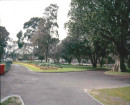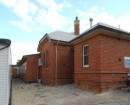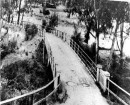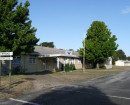GLENMONA BRIDGE
PYRENEES HIGHWAY BUNG BONG, CENTRAL GOLDFIELDS SHIRE, PYRENEES SHIRE
-
Add to tour
You must log in to do that.
-
Share
-
Shortlist place
You must log in to do that.
- Download report


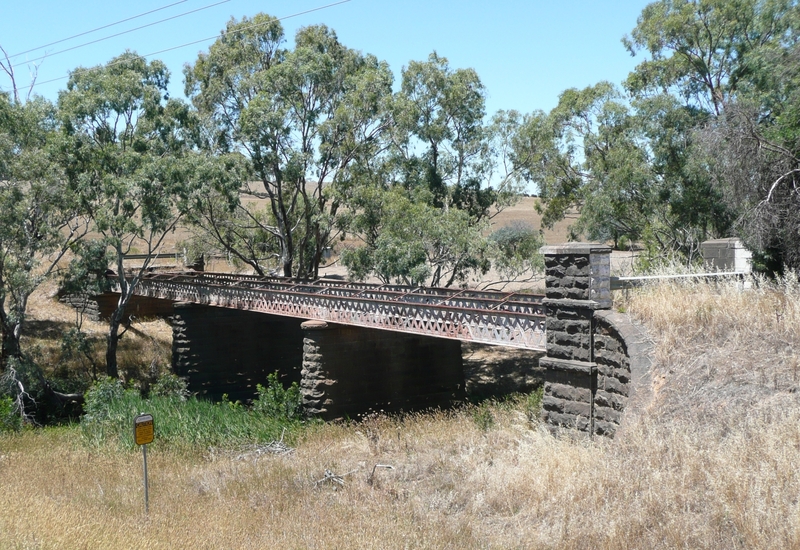
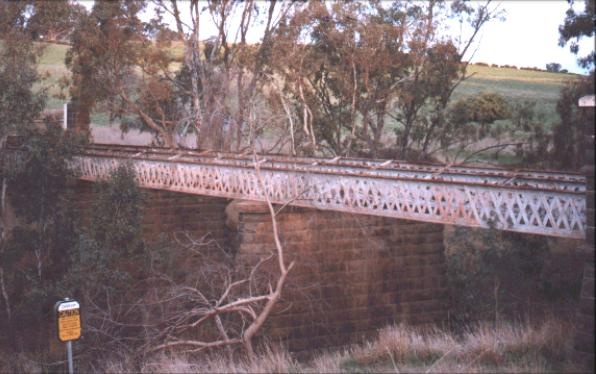

Statement of Significance
The old Glenmona Bridge is situated beside the modern bridge at the Bet Bet Creek crossing of the Pyrenees Highway at the site of the old Bung Bong township. It is a continuous wrought-iron lattice-girder deck-truss road bridge over three spans on bluestone-masonry abutments and piers. This crossing had been situated on a main northward communication link since pastoral days, and, during the gold rush, the main link between South Australia (Adelaide) and Mt Alexander. It remained a major trunk road until the years after World War One, when the Country Roads Board constructed the Calder Highway to north and north-western Victoria. The bridge was built in 1871 to replace a notable 1857 timber bridge which had been swept away in the freak state-wide floods of 1870. The piers are 10.1 metres high, and the truss 46.6 metres long. The deck, originally of two diagonal layers of 8 inch by 3 inch planks resting on three continuous wrought-iron lattice trusses, has been destroyed by fire. The tall bluestone abutments and piers are still in very good condition, and the wrought-iron lattice-girder trusses are intact, though now fully exposed to the weather. Its massive abutments, tall bluestone piers, and the wrought-iron lattice trusses provide an impressive sight to passing motorists.
How is it Significant?
The Glenmona Bridge is of scientific (technical), historical, and aesthetic significance to Victoria.
Why is it Significant?
It is of historical significance as an historic crossing place on a major early pastoral and mail route which linked central Victoria with north-central and west Victoria; in the hectic alluvial goldrushes of the early 1850s it was of even greater importance as the main route between South Australia and the Mount Alexander diggings.
It is of scientific (technical) significance as the prototype for a new series of locally constructed wrought-iron lattice-girder deck-truss main road bridges with masonry substructures and timber tops, created under the direction of a government bridge inspector specifically to handle the sort of freak floods experienced across Victoria in the winter and spring of 1870. It represents the next stage in Victorian iron bridge evolution, displacing the laminated-timber arch design that municipalities had often used in wide-channel situations, but which had fared badly in the 1870 floods. Its sophisticated locally produced wrought-iron lattice trusses also contrast with the more mundane iron plate girder and box girder designs for “permanent” bridges at a few rural crossings since the late 1860s. The design of the lattice-girder deck-truss bridge evolved as it became widely used in central Victoria and the Western District during the colonial era, with isolated examples being constructed as late as World War One. Its handsome iron trusses also reflect the evolving sophistication of colonial technology. Manufactured at a Ballarat iron works rather than imported from Britain, they are significant artifacts in the history of manufacturing in Victoria, with potential to provide technical information about Ballarat engineering circa 1870. Whereas the huge lattice truss girders of the Redesdale bridge (1868) had been imported from England in 1859, the colonial engineering works which had in the meantime developed to service reef and deep lead mining were quite capable of supplying such products by 1870.
It is of aesthetic significance for its substantial masonry piers and abutments, and its handsome trusses, which are an impressive sight from the nearby Pyrenees Highway.
-
-
GLENMONA BRIDGE - History
Contextual History:History of Place:
The historic crossing of the Bet Bet Creek at Bung Bong has played a very important role in Victorian overland communication since the earliest days of the colony of Victoria. This site had been on a major mail route linking central Victoria with north-central Victoria since the earliest days of white pastoral settlement.
The road and Bet Bet Creek crossing (at the time known as McNeil Creek) appears on the 1853 consolidated map of Victoria. The inclusion of the road on this map is sufficient to indicate an important regional road in the colony, almost certainly dating to the pioneering pastoral era. But the road, at the site of the bridge, is also annotated as follows: “Road fm S. Australia to Mt Alexander”. The route of this road passes from Castlemaine/Mt Alexander, through Bung Bong and then west north-westerly along the approximate line of the present townships of Avoca, Moonambel, Navarre, Callawadda, Longerenong, Horsham, Natimuk, to Lillimur South either across the Little Desert or via Dimboola, and thence to Bordertown and on to Adelaide. The Bung Bong crossing was part of the main route from South Australia into Victoria’s most fabulous alluvial goldfield, during its opening rush.
The first bridge at the crossing place dates from these goldrush days. At this time the original Glenmona Bridge at Bung Bong also carried the mail coaches heading north via Maryborough or Amhurst/Talbot and Avoca, towards St Arnaud and ultimately the Swan Hill district and the Riverina. The old route lost some of that vital early role when the Sandhurst Railway reached Bendigo in the 1860s and northern mail routes were re-aligned to connect with that railhead. However, it remained a major trunk road into northern Victoria even after the construction of the railway through St Arnaud, and the gradual decline of the once-thriving central-Victorian goldfield cities and towns. It lost some of its earlier significance in the years after World War 1, when the Country Roads Board constructed the Calder Highway as the main trunk route linking the metropolis with that part of northern Victoria.
For a brief period in the mid-to-late 1850s Victorian road construction and maintenance was under the control of a central road authority, called the Central Road Board. The future Amherst-Avoca Road project was in the back of the mind of the Central Road Board regional engineer based at Barker’s Creek (Maryborough), Clement Wilks, in 1857. He was then immersed in various serious bridge problems presented by construction of the Ballarat to Amherst main road, with which the proposed Amherst-Avoca Road would link. The Victorian Government Gazette for 1857 referred to a contract for a timber bridge across the Bet Bet Creek on the Avoca Road. Clement Wilks corresponded with his Melbourne superiors during May 1857, on the proposed Amhurst-Avoca Road: ‘the first step ... to make the line available for public traffic would be to have the road cleared during this winter in order to admit traffic during the ensuing Spring and Summer’.
That same month saw Wilks communicating with G. W. Harris of the Central Road Board, about a contract with A. Oughton to construct the original Glenmona Bridge. Wilks had previously supplied his superior with plans and specifications for this original timber bridge at the first Bet Bet Creek crossing on the Avoca Road. Simple timber bridge though it was, it was not cheap in that goldrush era. Bridge and abutments were priced at £1643, and with the extensive approach works the total cost would be £3215. The bridge must have been well under way by July 1857, when Wilks notified contractor Oughton at Avoca of two payments totalling over £800. The earliest explicit reference to the bridge having the name ‘Glenmona Bridge’ is dated October 1858, when Wilks alluded to the Oughton contract and ‘the amount of metal measured at Glenmona Bridge’. After the disastrous floods of the Spring of 1870 had demolished the original bridge, the name ‘Glenmona Bridge’ was transferred to its handsome successor at Bung Bong, constructed of stone masonry, iron and timber.
The flood ravages across Victoria made big news during 1870. As far away as Portland the passing of the original Glenmona Bridge between the 6th and 8th of September was lamented: ‘the fine wooden-bridge on the Avoca Road near Caleb Bennett’s has been swept away, entirely suspending communication with Talbot from the north-west. The bridge has been carried bodily down the stream about a hundred yards, and lies on the bank. The coaches were unable to cross the creek...’. Unfortunately for the Shire of Avoca, the substantial main road bridge over the Avoca River at Avoca was also so badly damaged as to require rebuilding. Initially, shire councillors seem to have assumed that they would receive government financial subsidies only on the big river bridge at Avoca, and that the cost of the new Glenmona Bridge would be divided between the neighbouring shires of Avoca and Talbot, on whose border the Bung Bong bridge was situated.
Avoca Shire seems to have lacked an engineer, and designing of the new bridge was handled by William Woods, Talbot Shire’s engineer. On the initial assumption that the two shires would bear sole financial responsibility, Woods designed a single-span laminated-timber-arch bridge for the site, the 120 feet span to cost £3000. In November the completed plans for this big timber Glenmona Bridge were presented and explained to Avoca Shire councillors by Woods, the cost estimate having risen slightly to £3270. Avoca Shire approved and adopted the timber-arch plans. Talbot Shire continued to advocate a toll on the bridge for six years, to contribute to construction costs, but the days of toll bridges were almost past and by the mid-1870s such tolls were officially abolished across Victoria.
By January 1871, the government engineer representing the Roads and Bridges section of the Public Works Department had suggested an alternative design utilizing wrought-iron main trusses. The record floods had played havoc with laminated-timber-arch bridges earlier built with government subsidies, and government engineers contemplated a new style of ‘permanent’ bridge utilising stone masonry, iron and timber. The prospect of attracting state flood-relief funds for the project encouraged the neighbouring shires to take the government engineer’s iron-bridge proposal seriously.
Local ratepayers were not all convinced of the need for an ‘expensive’ bridge. A meeting of delegates from Avoca and Talbot Shires at Bung Bong’s Bridge Inn had recently discussed the issue of a replacement Glenmona Bridge. One proposal considered was for a light timber bridge at an alternative crossing site, to cost a mere £150. However, the experience of the recent devastating floods ensured a quick demise for this scheme. Woods’ laminated-timber-arch design was also considered, but it was finally recommended that a masonry and iron bridge as proposed by government, ‘at an extra cost of some £300 or £400, should be substituted...’. The economics of colonial main-road bridge construction was changing, as wrought-iron bridges became competitive with more conventional masonry-and-timber designs.
The recommendation for an iron bridge went back to the two shire councils, and Avoca Shire considered it early in February 1871. In response to the government district engineer’s suggestion, shire engineer Woods from Talbot submitted an unfinished design for an iron-girder bridge, estimated to cost only £200 more than the laminated-timber arch proposal. Avoca Shire Council duly moved ‘that a permanent bridge be erected on the old site at Glenmona’, and Woods was told to complete his iron-bridge plans for further consideration. The grand new Glenmona Bridge constructed from stone masonry, wrought-iron trusses and timber would emerge from this planning process, doubtless with input from the government’s district engineer. The new bridge would involve three lengthy iron-lattice-truss spans and two big intermediate masonry piers, and would be 153 feet long in contrast to the 120 feet proposed for the earlier timber arch. This extra length permitted a higher level bridge, with high level approaches to counter any future ‘superflood’.
The foundation stone of the new Glenmona Bridge was laid early in May 1871, and the big bridge was completed in just over six months. The grand official opening on 13 November 1871 drew visitors from Avoca, Talbot, Amherst, Maryborough, Majorca, Carisbrook and Ballarat. The bridge contractors were Fishburn, Lewis and Co. of Ballarat, and the big wrought-iron lattice-truss girders were produced by John Price of Ballarat, with James Francis of Ballarat supervising as Clerk of Works. Whereas the huge lattice-truss girders used at Redesdale Bridge in 1868 had been imported from England a decade previously, colonial foundries and engineering works serving the gold-extraction industry were by 1870 quite capable of supplying this need. The handsome iron trusses of the new Glenmona Bridge (3 feet 6 inches by 12 inches) reflect the evolving sophistication of colonial technology. The total cost of the completed bridge had risen slightly to £3600, but that price compares favourably with the total price of £3663 paid in 1867 for the Ellerslie (Letts Ford) Bridge. The latter bridge was a more conventional strutted-corbel timber-beam and timber-pier bridge, with abutments and wing walls of stone masonry, the only wrought-iron work being in the wing-wall parapets.
At Bung Bong massive bluestone abutments and two tall intermediate masonry piers supported the big iron trusses, but to passing traffic Glenmona Bridge still looked like a traditional timber bridge. Huge 8 inch by 10 inch hardwood beams from Mt Cole timber reserve were seated across the iron trusses, to support two layers of 8 inch by 3 inch timber decking laid diagonally. The whole timber superstructure which included gravel beams and hand-crafted timber side rails was securely bolted down to the underlying iron trusses, which were themselves held together by more than 14,000 rivets. The Maryborough Advertiser could proudly claim that this was ‘without doubt, one of the finest, neatest, strongest, and most compact bridges in the colony’.
The grand official opening of new Glenmona Bridge was an historic occasion in itself. The bridge was ‘opened’ from both ends, so that official deputations and visitors from the Talbot and Avoca sides met in the middle. Mrs Woods, wife of the designing engineer, officially christened ‘the Glenmona Bridge’ by breaking a bottle of champagne above mid-stream. Shire President Nichol of Talbot Shire officially declared the bridge deck open for traffic, and the official party retreated to Caleb Bennett’s conveniently located hotel where a ‘collation was partaken’, interrupted only by toasts and speeches. To ‘considerable applause’ Mr John Cooke of Avoca read his poem appropriately entitled ‘Opening of the Bung Bong Bridge’, which verse has not come down to posterity. Photographers from Maryborough and Ballarat were present to photograph the celebrating crowd posed very still upon the bridge, and photographs were duly forwarded to the Illustrated London News and Illustrated Australian News. This was no ordinary Bung Bong day.
Glenmona Bridge took its name from the historic squatting run of Glenmona, which included the earlier pastoral runs of Scarborough and Far Creek or Fourteen Mile Creek, instituted in 1839-40. I can find in nineteenth-century Scottish records no record of a place or estate named Glenmona, the nearest being Glenmon, the estate of John Campbell near Oban in Argyll. The combined run of Glenmona dated from July 1845 when it was in the hands of E. McNeill and C. B. Hall. At the time of the bridge’s opening the squatting run was held by John Matheson, so presumably the ‘Mr Sutherland of Glenmona’ mentioned in the report on the grand opening was a station superviser for an absentee squatter.
Minor repairs to the Bung Bong Bridge were required in January 1889, probably as a result of the next disastrous flood to hit central Victoria in the new year of 1889. The small repair bill of £40 indicates that the designers of the bridge had done their job well. By 1901 the thirty-year-old timber decking needed extensive repair works, with the government supplying £225 on condition that the neighbouring shires contributed £450 additional. Between March 1900 and December 1901 a considerable correspondence about Glenmona Bridge took place between the Public Works Department and the local shires, which suggests that the bridge was probably completely redecked. Victoria’s Country Roads Board took over the old bridge in 1914, and repairs and painting of the timber work took place in 1919-20.
The final ignominy for the proud old structure occurred in 1985, when fire destroyed the extensive timber element of the superstructure, leaving a skeletal framework of iron lattice girders seated high upon the big bluestone abutments and piers over the Bet Bet Creek. The Talbot and Clunes Conservation Study summed up the current situation: ‘A sophisticated early bridge which stands on one of the earliest bridge sites in the shire. Despite fire damage the bridge still has considerable aesthetic appeal ...’.GLENMONA BRIDGE - Assessment Against Criteria
Criterion A.
The historical importance, association with or relationship to Victoria's history of the place or object.
It is situated on an historic crossing place of a major early pastoral and mail route which linked central Victoria with north-central and west Victoria.
In the hectic alluvial goldrushes of the early 1850s it was of even greater importance as the main route between South Australia and the Mount Alexander diggings.
Criterion B.
The importance of a place or object in demonstrating rarity or uniqueness.
Criterion C.
The place or object's potential to educate, illustrate or provide further scientific investigation in relation to Victoria's cultural heritage.
The iron trusses were manufactured at a Ballarat iron works, rather than imported from Britain, are significant artifacts in the history of manufacturing in Victoria, with potential to provide technical information about Ballarat engineering circa 1870.
Criterion D.
The importance of a place or object in exhibiting the principal characteristics or the representative nature of a place or object as part of a class or type of places or objects.
Criterion E.
The importance of a place or object in exhibiting good design or aesthetic characteristics and/or in exhibiting a richness, diversity or unusual integration of features.
The bridge is a composite structure, combining bluestone, iron and timber to best and most economical effect. It was a prototype for the widespread use of the lattice deck-truss to bridge wide channel crossings in rural Victoria during the colonial era.
Criterion F.
The importance of a place or object in demonstrating or being associated with scientific or technical innovations or achievements.
It was the prototype for a new series of locally constructed wrought-iron lattice-girder deck-truss main road bridges with masonry substructures and timber tops, created under the direction of a government bridge inspector specifically to handle the sort of freak floods experienced across Victoria in the winter and spring of 1870. It represents the next stage in Victorian iron bridge evolution, displacing the laminated-timber arch design that municipalities had often used in wide-channel situations, but which had fared badly in the 1870 floods. Its sophisticated locally produced wrought-iron lattice trusses also contrast with the more mundane iron plate girder and box girder designs for "permanent" bridges at a few rural crossings since the late 1860s. The design of the lattice-girder deck-truss bridge evolved as it became widely used in central Victoria and the Western District during the colonial era, with isolated examples being constructed as late as World War One.
Its iron trusses also reflect the evolving sophistication of colonial technology. Whereas the huge lattice truss girders of the Redesdale bridge (1868) had been imported from England in 1859, the colonial engineering works which had in the meantime developed to service reef and deep lead mining were quite capable of supplying such products by 1870.
Criterion G.
The importance of a place or object in demonstrating social or cultural associations.
Criterion H.
Any other matter which the Council considers relevant to the demonstration of cultural heritage significance.
It is of aesthetic significance for its substantial masonry piers and abutments, and its handsome trusses, which are an impressive sight from the nearby Pyrenees Highway, and an enduring symbol of a long-departed colonial era.GLENMONA BRIDGE - Permit Exemptions
General Exemptions:General exemptions apply to all places and objects included in the Victorian Heritage Register (VHR). General exemptions have been designed to allow everyday activities, maintenance and changes to your property, which don’t harm its cultural heritage significance, to proceed without the need to obtain approvals under the Heritage Act 2017.Places of worship: In some circumstances, you can alter a place of worship to accommodate religious practices without a permit, but you must notify the Executive Director of Heritage Victoria before you start the works or activities at least 20 business days before the works or activities are to commence.Subdivision/consolidation: Permit exemptions exist for some subdivisions and consolidations. If the subdivision or consolidation is in accordance with a planning permit granted under Part 4 of the Planning and Environment Act 1987 and the application for the planning permit was referred to the Executive Director of Heritage Victoria as a determining referral authority, a permit is not required.Specific exemptions may also apply to your registered place or object. If applicable, these are listed below. Specific exemptions are tailored to the conservation and management needs of an individual registered place or object and set out works and activities that are exempt from the requirements of a permit. Specific exemptions prevail if they conflict with general exemptions. Find out more about heritage permit exemptions here.Specific Exemptions:General Conditions:
1. All exempted plans and alterations are to be carried out in a manner which prevents damage to the fabric of the registered place or object.
2. Should it become apparent during further inspection or the carrying out of alterations that original or previously hidden or inaccessible details of the place or object are revealed which relate to the significance of the place or object, then the exemption covering such alteration shall cease and the Executive Director shall be notified as soon as possible.
3. If there is a conservation policy or plan approved by the Executive Director, all works shall be in accordance with it.
4. Nothing in this declaration prevents the Executive Director from amending or rescinding all or any of the permit exemptions.
5. Nothing in this declaration exempts owners or their agents from the responsibility to seek relevant planning or building permits from the responsible authority where applicable.
Specific Provisions/Exemptions
No permit is required for routine maintenance or minor repairs which replace like with like.GLENMONA BRIDGE - Permit Exemption Policy
It is the purpose of the permit exemptions to enable routine maintenance and repairs which do not damage the significant fabric of the place, or diminish its cultural significance.
-
-
-
-
-
GLENMONA BRIDGE
 Victorian Heritage Register H1846
Victorian Heritage Register H1846 -
Glenmona Bridge
 National Trust H1846
National Trust H1846
-
'Boonderoo', House and Outbuildings
 Greater Bendigo City
Greater Bendigo City -
'Riverslea' house
 Greater Bendigo City
Greater Bendigo City -
1 Adam Street
 Yarra City
Yarra City
-
-





